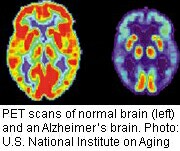Research in mice is preliminary, but may have potential to combat the disease
THURSDAY, March 12, 2015 (HealthDay News) — Preliminary research in mice raises the possibility that an ultrasound-based treatment might help eliminate amyloid-β (Aβ) plaque in the brain. The study appears in the March 11 issue of Science Translational Medicine.
The researchers applied ultrasound to mice with Alzheimer’s-like disease after injecting them with “microbubbles” that vibrate when they encounter ultrasound signals. “In our treatment, ultrasound acts on the microbubbles, causing them to expand and contract in the blood vessels of the brain,” study coauthor Gerhard Leinenga, a graduate student at the University of Queensland in Brisbane, Australia, told HealthDay. This disrupts the “blood-brain barrier,” which protects the brain from germs in the blood, Leinenga said, apparently allowing molecules to enter the brain and activate cells that “eat” amyloid plaque.
The technique appeared to reduce levels of Aβ plaque in the treated mice and nearly eliminate it in 75 percent of the animals — without damaging brain tissue. The treated mice also performed better on memory tests, including a maze, places of avoidance, and object recognition, the researchers said.
Scientists don’t know whether the approach is feasible for humans, but the research is promising, especially because of how well mice with an Alzheimer’s-like disease fared after treatment, Leinenga said.
Copyright © 2015 HealthDay. All rights reserved.








